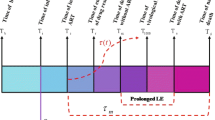Abstract
RNA viruses, including relrovimses. have Mutation rates that are about 100 limes higher than those of DNA viruses, bacteria, or eukaryotes, so that resistance to AIDS drugs emerges very rapidly. This has been shown to limil the effectiveness of the treatment of AIDS by reverse transcriptase inhibitors, such as zidovudine (AZT) and resistance to the new class of HIV aspartyl protease inhibitors has already been reported. The technique of pharmacokinetic–pharmacodynamic simulation has now been used to predict ways of delaying the development of resistance to these two classes of antiretroviral agents. A model is described that includes pharmacokinetic, pharmacodynamic, and cytokinetic equations, and expressions describing effects of the HIV on the immune system and destruction of virally infected cells by cellular immunity. The model predicted that the degree of viral drug resistance in relation to ike sustainable blood level of drug would be the major determinant of response duration. Early treatment was consistently superior to late treatment, both with a drug that caused cumulative loxicity and with a drug that did not. Making reasonable assumptions about the likely degree of viral resistance, in conjunction with typical blood levels achievable for reverse transcriptase inhibitors or aspartyl protease inhibitors led to predicted response durations of several months to a few years, despite the rapid mutation rate of HIV. Preliminary studies of combination chemotherapy showed that predicted response durations were greater than for monotherapy, though less than the sum of responses to the individual drugs. Strategies for delaying the development of resistance include early treatment, combination chemotherapy, and developing novel agents with a high ratio of plasma level to antiviral efficacy.
Similar content being viewed by others
REFERENCES
D. D. Richman. HIV drug resistance. Ann. Rev. Pharmacol. Toxicol. 32:149–164 (1993).
P. S. Sarin. Molecular pharmacologic approaches to the treatment of AIDS. Ann. Rev. Pharmacol. Toxicol. 28:411–428 (1988).
T. Ridky and J. Leis. Development of drug resistance to HIV-1 protease inhibitors. J. Biol. Chem. 270:29261–29263 (1995).
A. R. McLean, V. C. Emery, A. Webster, and P. D. Griffiths. Population dynamics of HIV within an individual after treatment with zidovudine. AIDS 5:485–489 (1991).
R. A. Weiss. How does HIV cause AIDS? Science 260:1273–1279 (1993).
M. A. Nowack, R. M. Anderson, A. R. McLean, T. F. W. Wolfs, J. Goudsmit, and R. M. May. Antigenic diversity thresholds and the development of AIDS. Science 254:963–969 (1991).
M. A. Nowack and R. M. May. Mathematical biology of HIV infections: antigenic variation and diversity threshold. Math. Biosci. 106:1–21 (1991).
M. A. Nowack and R. M. May. Coexistence and competition in HIV infections. J. Theoret. Biol. 159:329–342 (1992).
P. G. Welling. Pharmacokinetics: Processes and Mathematics, American Chemical Society, Washington, DC, 1986, p. 165.
A. V. Hill. The possible effects of the aggregation of the molecules of haemoglobin on its dissociation curves. J. Physiol. (London) 40:4–16 (1910).
T.-C. Chou and P. Talalay. Quantitative analysis of dose-effect relationships: the combined effects of multiple drugs or enzyme inhibitors. Adv. Enzyme Reg. 22:27–55 (1984).
S. E. Luria and M. Delbrück. Mutations of bacteria from virus sensitivity to virus resistance. Genetics 28:491–511 (1943).
M. Eigen. Viral quasispecies. Sci. Am. 269:42–49 (1993).
J. M. Coffin. HIV population dynamics in vivo: implications for genetic variation, pathogenesis, and therapy. Science 267:483–489 (1995).
W. H. Press, B. P. Flannery, S. A. Teukolsky, and W. T. Vetterling. Numerical Recipes in C: The Art of Scientific Programming, Cambridge University Press, Cambridge, U.K., 1988.
B. Shetty, M. B. Kosa, D. A. Khalil, and S. Webber. Preclinical pharmacokinetics and distribution to tissue of AG-1343, an inhibitor of numan immunodeficiency virus type 1 protease. Antimicrob. Agents Chemother. 40:110–114 (1996).
X. Wei, S. K. Ghosh, M. E. Taylor, et al. Viral dynamics in human immunodeficiency type I infection. Nature 373:117–122 (1995).
D. D. Ho, A. U. Neumann, A. S. Perelson, W. Chen, J. M. Leonard, and M. Markowitz. Rapid turnover of plasma virions and CD4 lymphocytes in HIV-1 infection. Nature 373:123–126 (1995).
A. N. Phillips. Reduction of HIV concentration during acute infection: independence from a specific immune response. Science 271:497–499 (1996).
A. K. Patick, H. Mo, M. Markowitz, K. Appelt, B. Wu, L. Musick, V. Kalish, S. Kaldor, S. Reich, D. Ho, and S. Webber. Antiviral and resistance studies of AG1343, an orally bioavailable inhibitor of human immunodeficiency virus protease. Antimicrob. Agents Chemother. 40:292–297 (1996).
J. P. Sommadossi and R. Carlisle. Toxicity of 3′-azido-3′-deoxythymidine and 9-(1,3-dihydroxy-2-propoxymethyl)guanine in normal human hematopoietic progenitor cels in vitro. Antimicrob. Agents Chemother. 31:452–454 (1987).
H. E. Skipper, F. M. Schabel, and W. S. Wilcox. Experimental evaluation of potential anticancer agents. XIII. On the criteria and kinetics associated with curability of experimental leukemia. Cancer Chemother. Rep. 35:1–111 (1964).
Author information
Authors and Affiliations
Rights and permissions
About this article
Cite this article
Jackson, R.C. A Pharmacokinetic–Pharmacodynamic Model of Chemotherapy of Human Immunodeficiency Virus Infection that Relates Development of Drug Resistance to Treatment Intensity. J Pharmacokinet Pharmacodyn 25, 713–730 (1997). https://doi.org/10.1023/A:1025781801322
Published:
Issue Date:
DOI: https://doi.org/10.1023/A:1025781801322




